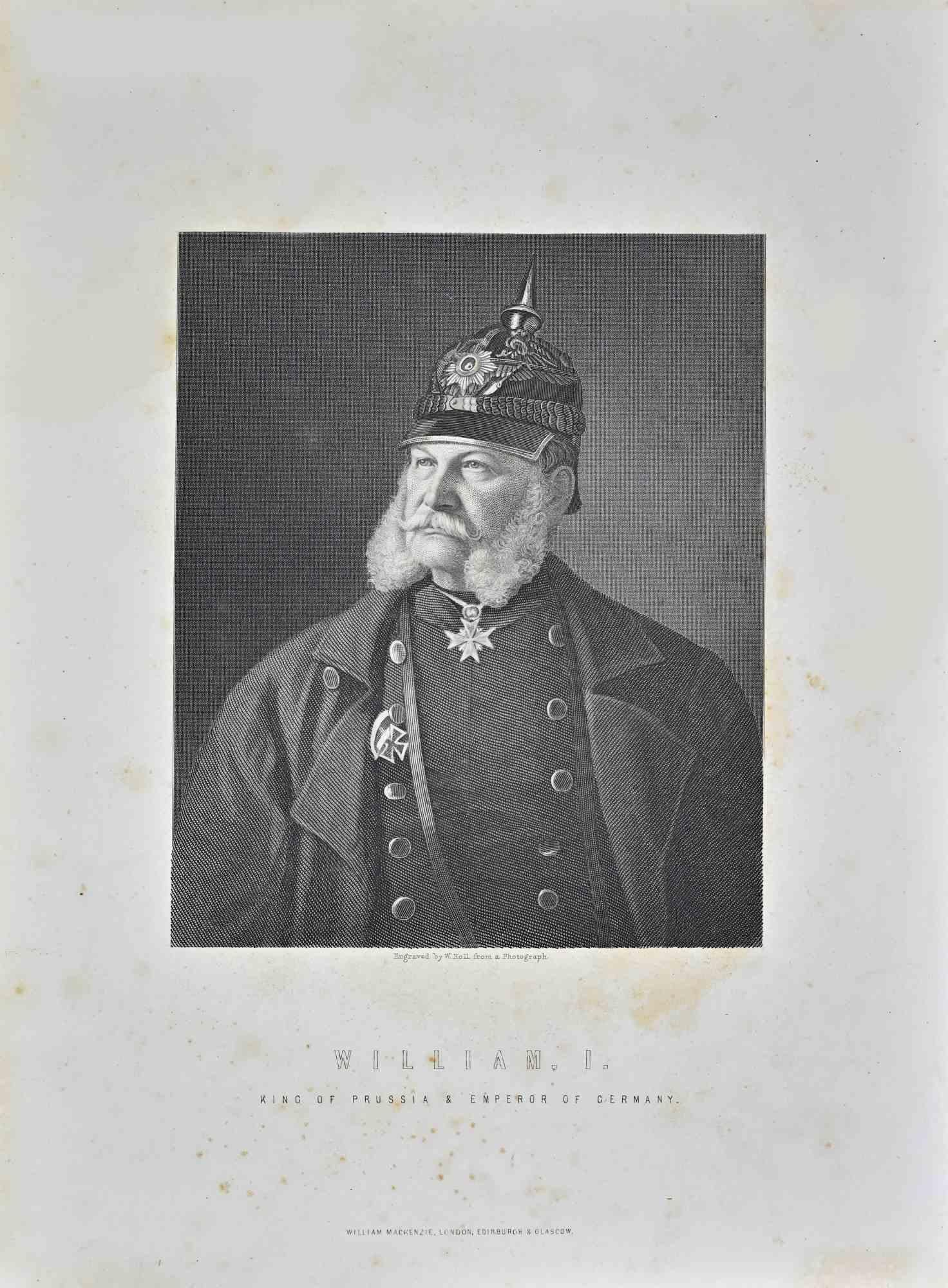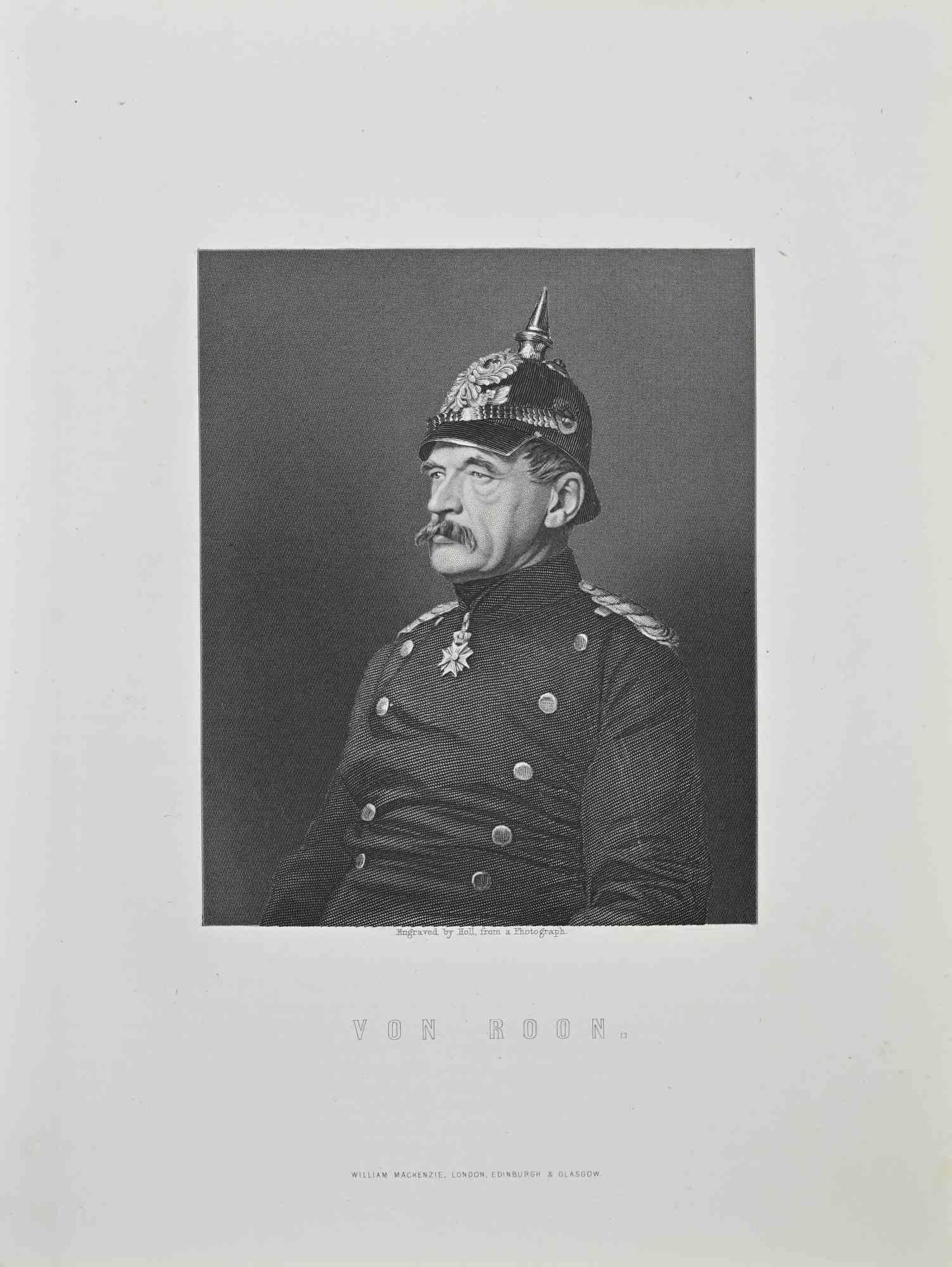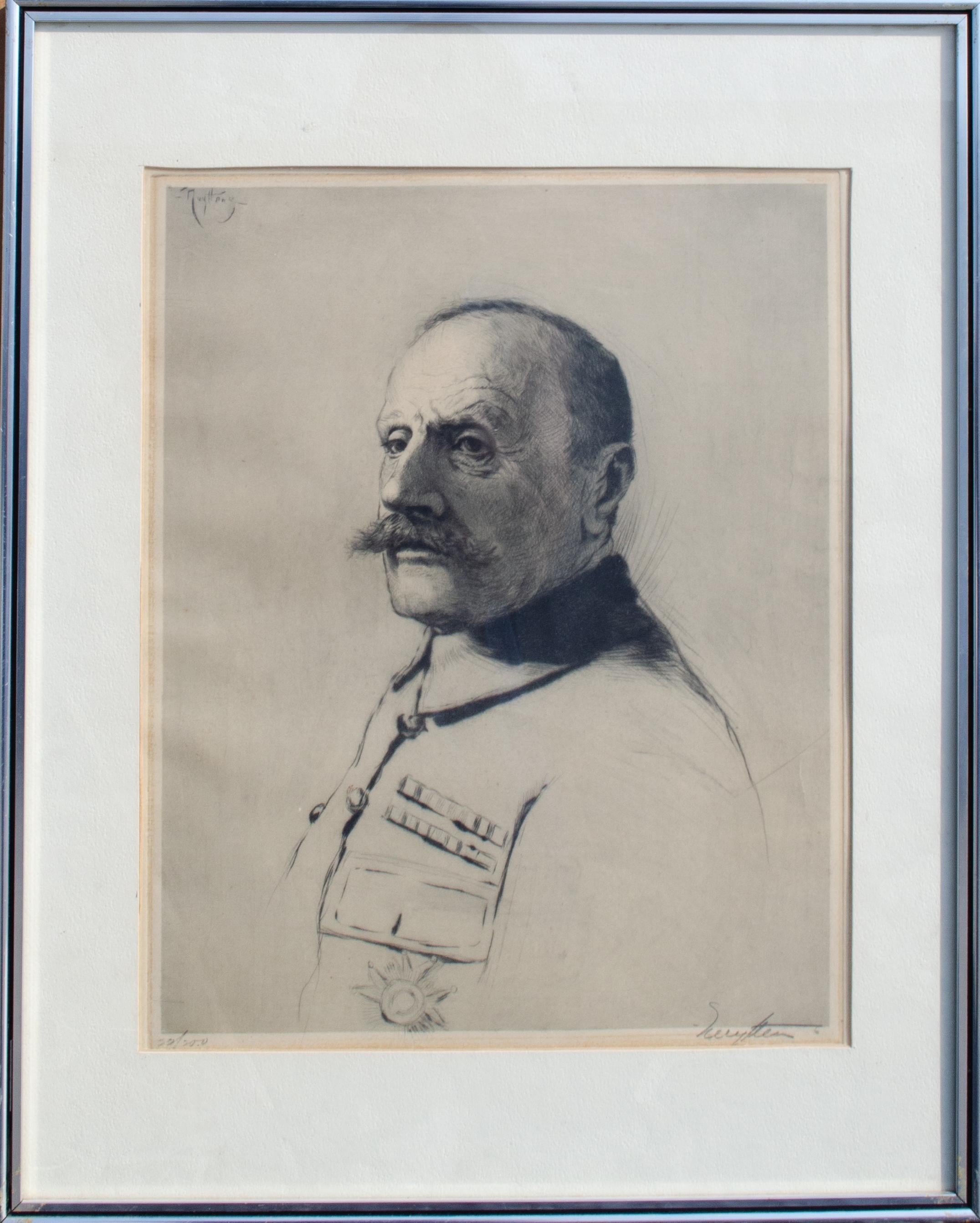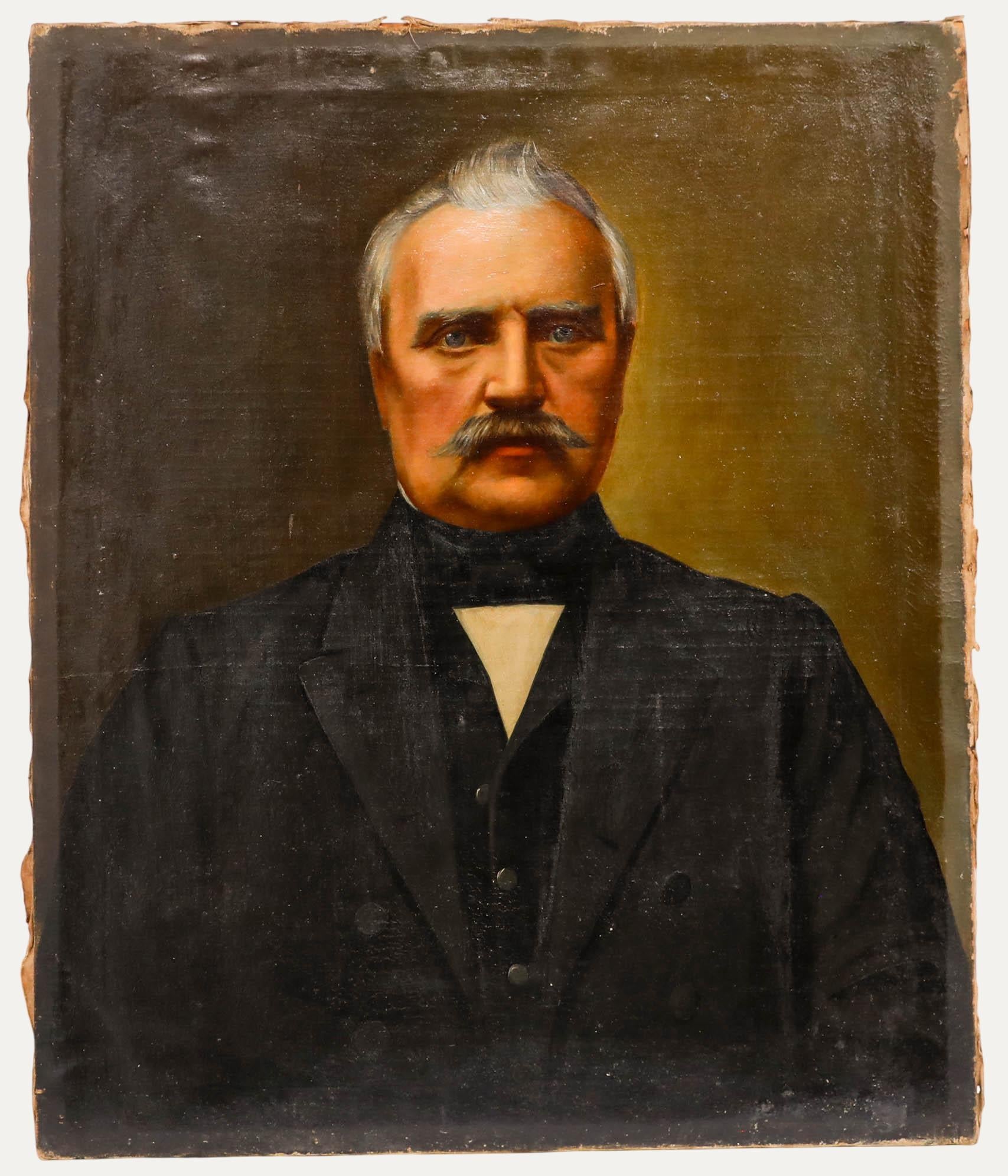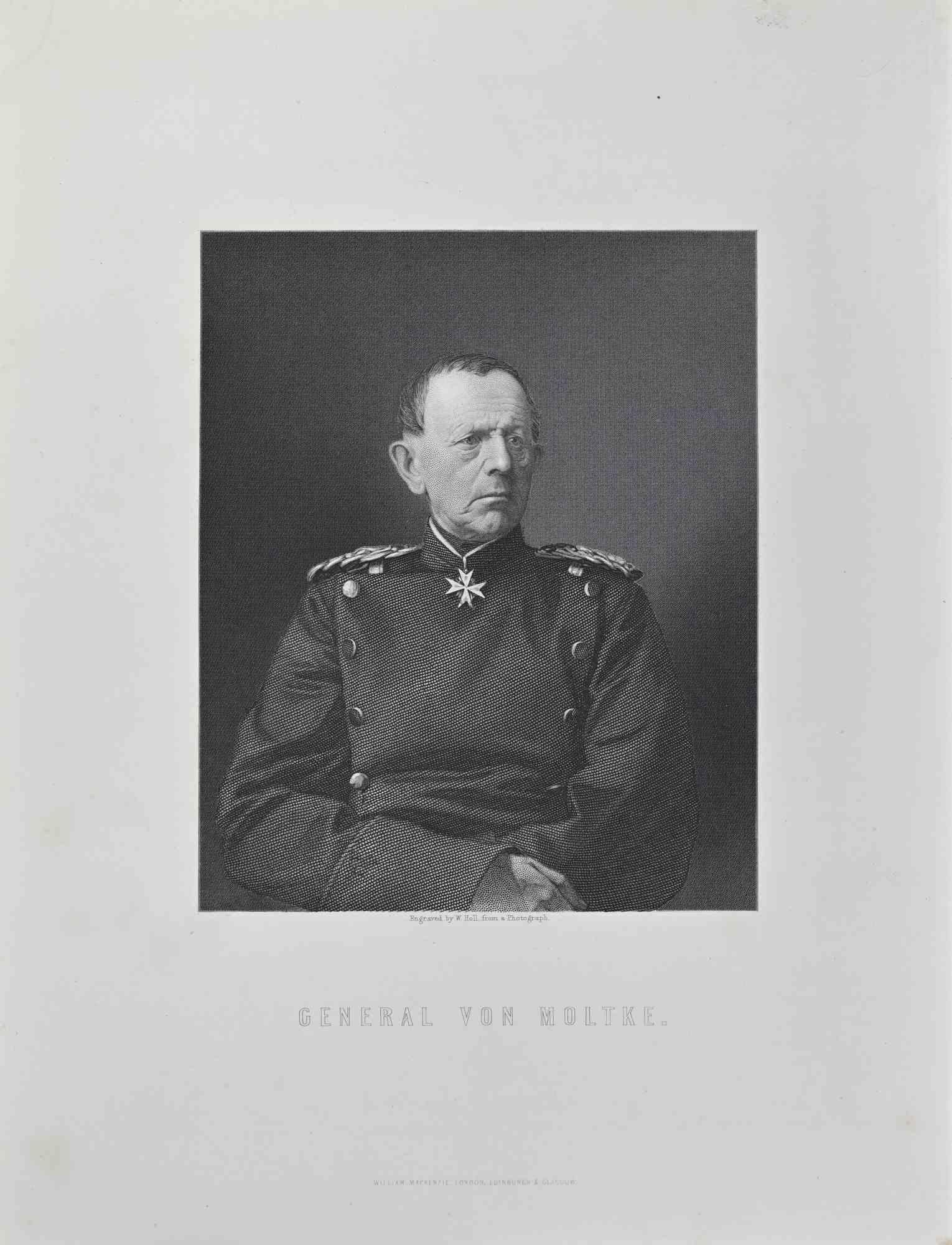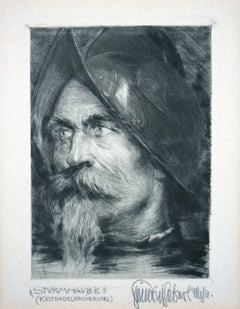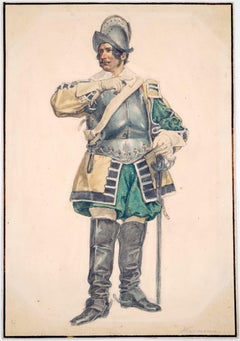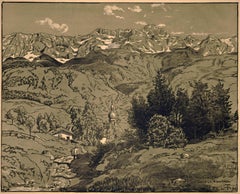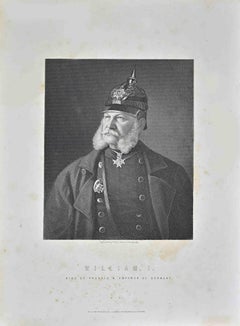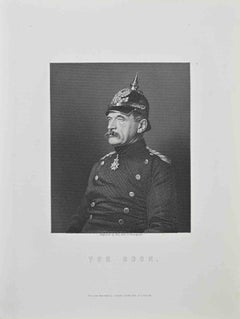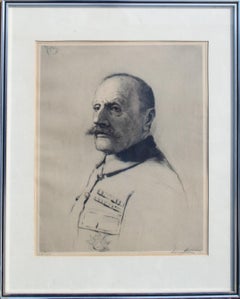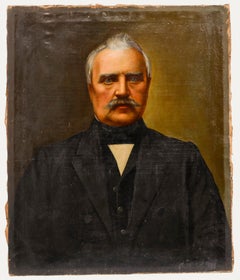Items Similar to General Wilhelm von Blume - Visionary retrospective -
Want more images or videos?
Request additional images or videos from the seller
1 of 10
Bernhard PankokGeneral Wilhelm von Blume - Visionary retrospective -1915
1915
$455.96
$569.9520% Off
£344.60
£430.7520% Off
€384
€48020% Off
CA$636.94
CA$796.1820% Off
A$692.92
A$866.1620% Off
CHF 365.65
CHF 457.0620% Off
MX$8,333.62
MX$10,417.0220% Off
NOK 4,612.48
NOK 5,765.6020% Off
SEK 4,292.64
SEK 5,365.8120% Off
DKK 2,925.21
DKK 3,656.5120% Off
About the Item
Bernhard Pankok (1872 Münster - 1943 Baierbrunn), General Wilhelm von Blume, 1915, aquatint etching, 34 x 29.5 cm (sheet size), 26 x 22 cm (plate size), signed in the plate at upper left, in pencil at lower right and dated in pencil at lower left.
- At lower left old collection stamp, at the right broad margin with a small spot, otherwise very good condition.
About the artwork
The 1915 aquatint etching of General Wilhelm von Blume is based on a 1912 oil painting in the LWL-Museum für Kunst und Kultur in Münster. A second oil portrait of the general by Pankok is in the Staatsgalerie Stuttgart. When Pankok painted the first oil portrait in 1912, the general had already been retired for 16 years. It is therefore a retrospective portrait. Accordingly, the orientation of his head is such that he is looking back in both the oil painting and the etching. Without fixing on anything in particular, he looks thoughtfully inwards and reflects on his life. Uniformed and highly endowed, it is his military activities in particular that he is reviewing attentively and, as his gaze reveals, quite critically.
Pankok has literally written the sum of his experiences on Wilhelm von Blume's face: The physiognomy is a veritable landscape of folds, furrows, ridges and gullies, all the more striking against the flat background. It is clear that each of the medals was also won through suffering. However, by breaking the boundaries of the picture, his bust appears as an unshakable massif, which gives the general a stoic quality.
The fact that the design of the portrait was important to Pankok can be seen from the different versions, the present sheet being the third and probably final revision, which Pankok dates precisely to 18 February 1915. Compared with the previous state, the light background now has a dark area against which the sitter's face stands out, the dark background in turn combining with the uniform to create a new tension in the picture.
Pankok's taking up of the portrait of the high-ranking military veteran and its graphic reproduction can also be seen in relation to the First World War, which had broken out in the meantime. In the face of modern weapons of mass destruction, Wilhelm von Blume's warfare and military writings were relics of a bygone, more value-oriented era.
About the artist
After studying at the Düsseldorf Art Academy from 1889 to 1891 under Heinrich Lauenstein, Adolf Schill, Hugo Crola, and Peter Janssen the Elder, Bernhard Pankok went to Munich in 1892, where he worked primarily as a graphic artist for the two major Jugendstil magazines "Pan" and "Jugend," which established his artistic success. Through this work he met Emil Orlik, with whom he had a lifelong friendship.
In 1897, he exhibited his first furniture, and in 1898, together with Richard Riemerschmid, Bruno Paul and Hermann Obrist, he founded the Vereinigte Werkstätten für Kunst im Handwerk. At the Paris World Fair of 1900, he was awarded the Grand Prix for the design of an oriel room.
His work as an architect also began with the construction of the Lange Haus in Tübingen in 1901. In the spirit of the Arts and Crafts Movement, Pankok was a "universal artist" for whom art was not divided into "high art" and "applied art," but represented something comprehensive that extended to everyday objects.
Also in 1901, he married Antonette Coppenrath, a sister of the landscape painter Ferdinand Coppenrath, and in the same year he was appointed to the Royal Teaching and Experimental Workshop of the Stuttgart Arts and Crafts School. With the completion of the new building of the Kunstgewerbeschule, which had been built according to Pankok's designs since 1908, Pankok became its director in 1913, a position he held until 1937.
In 1907 Pankok became a member of the Berlin Secession and the Deutscher Werkbund. He went on to design salons for steamships and cabins for zeppelins, as well as stage sets for operas. Pankok was one of the leading artists at the groundbreaking Werkbund exhibition in Cologne in 1914. Because of his reputation, he was made a foreign member of the Munich Secession in 1930, an honorary member of the Westphalian Art Society in Münster in 1932, and an honorary member of the Academy of Fine Arts in Munich a year later.
Although urged to do so, Pankok refused membership in the NSDAP and retired in 1937.
Selected bibliography
Birgit Hahn-Woernle / Hans Klaiber (Hrsg): Bernhard Pankok, 1872-1943. Kunsthandwerk, Malerei, Graphik, Architektur, Bühnenausstattungen, Stuttgart 1973.
Hans Klaiber: Bernhard Pankok. Ein Lebensbild (= Beiträge zur Geschichte der Staatlichen Akademie der Bildenden Künste Stuttgart, 4), Stuttgart 1981.
Angelika Lorenz (Hrsg.): Bernhard Pankok. Malerei, Graphik, Design im Prisma des Jugendstils, Münster 1986.
Gudrun Wessing: Bernhard Pankok als Porträtmaler, Münster 1988.
Mechthild Heinen: Bernhard Pankok. Das gebrauchsgraphische Werk, Freiburg 1993.
Eva-Marina Froitzheim: Bernhard Pankok - Ein Multitalent um 1900, Böblingen 2006.
Andrea Richter: Vom Ideal, alle Künste gleichzeitig zu beherrschen. Das Gesamtkunstwerk bei Bernhard Pankok. In: Carla Heussler u- Christoph Wagner (Hrsg.): Stuttgarter Kunstgeschichten, von den schwäbischen Impressionisten bis zur Stuttgarter Avantgarde (Regensburger Studien zur Kunstgeschichte, 21), Regensburg 2022, S. 44–59.
GERMAN VERSION
Bernhard Pankok (1872 Münster – 1943 Baierbrunn), General Wilhelm von Blume, 1915, Aquatintaradierung, 34 x 29,5 cm (Blattgröße), 26 x 22 cm (Plattengröße), links oben in der Platte, rechts unten in Blei signiert und unten links in Blei datiert.
- links unten alter Sammlungsstempel, am rechten breiten Rand mit kleinem Fleck, sonst in sehr gutem Zustand
zum Kunstwerk
Die 1915 entstandene Aquatintaradierung des Generals Wilhelm von Blume geht auf ein Ölbild aus dem Jahre 1912 zurück, das sich m LWL Museum für Kunst und Kultur Münster befindet. Ein zweites Porträt des Generals in Öl aus der Hand Pankoks gehört der Staatsgalerie Stuttgart. Als Pankok 1912 das vorbildliche Ölporträt geschaffen hatte, befand sich der General bereits 16 Jahre im Ruhestand. Es handelt sich folglich um ein retrospektives Porträt. Dementsprechend ist die Ausrichtung des Kopfes so gewählt, dass er sowohl auf dem Ölbild als auch der Radierung zurückblickt. Ohne etwas Konkretes zu fixierten, sieht er sinnierend nach innen und hält Rückschau auf sein Leben. Uniformiert und hoch dotiert dargestellt, ist es vor allem sein militärisches Wirken, das er aufmerksam und – wie sein Blick verrät – durchaus kritisch Revue passieren lässt.
Pankok hat Wilhelm von Blume die Summe seiner Erfahrungen förmlich ins Gesicht geschrieben: Die Physiognomie bildet eine regelrechte Landschaft aus Faltungen, Furchen, Erhebungen und Schluchten, was vor dem flächenförmigen Hintergrund umso mehr zur Geltung kommt. Es wird deutlich, dass jeder der Orden auch durch Leid errungen worden ist. Aufgrund der die Bildgrenzen sprengende Darstellung wirkt seine Büste jedoch wie ein unerschütterliches Massiv, was dem General einen stoischen Zug verleiht.
Dass Pankok die Gestaltung des Porträts wichtig war, zeigt sich allein schon an den verschiedenen Zuständen, wobei es sich bei dem vorliegenden Blatt um die dritte, wohl finale Überarbeitung handelt, die Pankok tagesgenau auf den 18.2.1915 datiert. Im Vergleich zum Zustand davor weist der dort helle Hintergrund nun einen dunklen Bereich auf, vor dem sich das Antlitz des Dargestellten abhebt, wobei sich der dunkle Fond seinerseits mit der Uniform verbindet und dadurch eine neue Spannung ins Bild setzt.
Pankoks Aufgreifen seines Porträts des hochrangigen Militärveteranen und dessen druckgrafische Vervielfältigung ist auch vor dem Hintergrund des inzwischen ausgebrochenen Ersten Weltkrieges zu sehen. Kriegshandlungen mit all ihren Leidensgeschichten waren wieder an der Tagesordnung, wobei Wilhelm von Blumes Kriegsführung und seine militärischen Schriften angesichts der modernen Massenvernichtungswaffen Relikte aus einer untergegangenen werteorientierteren Zeit sind.
zum Künstler
Nach dem Studium an der Düsseldorfer Kunstakademie von 1889 bis 1891 unter Heinrich Lauenstein, Adolf Schill, Hugo Crola und Peter Janssen d. Ä. ging Bernhard Pankok 1892 nach München und war dort vor allem als Grafiker für die beiden großen Zeitschriften des Jugendstils „Pan“ und „Jugend“ tätig, was seinen künstlerischen Erfolg begründete. Durch diese Tätigkeit lernte er Emil Orlik kennen, mit dem ihn eine lebenslange Freundschaft verband.
1897 stellte er seine ersten Möbel aus und war 1898 neben Richard Riemerschmid, Bruno Paul und Hermann Obrist Begründer der Vereinigten Werkstätten für Kunst im Handwerk. Auf der Pariser Weltausstellung von 1900 wurde er für die Gestaltung eines Erkerzimmers mit dem „Grand Prix“ ausgezeichnet.
Mit dem Bau des Hauses Lange in Tübingen im Jahre 1901 begann zudem seine Tätigkeit als Architekt. Damit war Pankok im Geiste der Arts-and-Crafts Bewegung ein ‚Universalkünstler‘, für den die Kunst nicht in eine ‚Hochkunst‘ und eine ‚angewandte Kunst‘ zerfällt, sondern etwas Umfassendes darstellt, dass bis in die Alltagsgegenstände hineinreicht.
Ebenfalls 1901 ehelichte er Antonette Coppenrath, eine Schwester des Landschaftsmalers Ferdinand Coppenrath und erhielt im selben Jahr einen Ruf an die Königlichen Lehr- und Versuchswerkstätte der Kunstgewerbeschule Stuttgart. Mit der Fertigstellung des ab 1908 nach Pankoks Entwürfen errichteten Neubaus der Kunstgewerbeschule wurde Pankok 1913 ihr Direktor und hatte diesen Posten bis 1937 inne.
1907 wurde Pankok Mitglied der Berliner Secession und des Deutschen Werkbundes. In der Folge entwarf er unteren anderem Salons für Dampfschiffe und Kabinen für Zeppeline, schuf aber auch Bühnenbilder für Opern. Auf der wegweisenden Kölner Werkbundausstellung des Jahres 1914 war Pankok einer der führenden Künstler. Aufgrund seiner Reputation wurde er 1930 zum auswärtigen Mitglied der Münchner Sezession, 1932 zum Ehrenmitglied des Westfälischen Kunstvereins Münster und ein Jahr später zum Ehrenmitglied der Akademie der Bildenden Künste München ernannt.
Obwohl er dazu gedrängt wurde, hat sich Pankok einer Mitgliedschaft in der NSDAP verweigert und ist 1937 in den Ruhestand getreten.
Auswahlbibliographie
Birgit Hahn-Woernle / Hans Klaiber (Hrsg): Bernhard Pankok, 1872-1943. Kunsthandwerk, Malerei, Graphik, Architektur, Bühnenausstattungen, Stuttgart 1973.
Hans Klaiber: Bernhard Pankok. Ein Lebensbild (= Beiträge zur Geschichte der Staatlichen Akademie der Bildenden Künste Stuttgart, 4), Stuttgart 1981.
Angelika Lorenz (Hrsg.): Bernhard Pankok. Malerei, Graphik, Design im Prisma des Jugendstils, Münster 1986.
Gudrun Wessing: Bernhard Pankok als Porträtmaler, Münster 1988.
Mechthild Heinen: Bernhard Pankok. Das gebrauchsgraphische Werk, Freiburg 1993.
Eva-Marina Froitzheim: Bernhard Pankok - Ein Multitalent um 1900, Böblingen 2006.
Andrea Richter: Vom Ideal, alle Künste gleichzeitig zu beherrschen. Das Gesamtkunstwerk bei Bernhard Pankok. In: Carla Heussler u- Christoph Wagner (Hrsg.): Stuttgarter Kunstgeschichten, von den schwäbischen Impressionisten bis zur Stuttgarter Avantgarde (Regensburger Studien zur Kunstgeschichte, 21), Regensburg 2022, S. 44–59.

About the Seller
5.0
Vetted Professional Seller
Every seller passes strict standards for authenticity and reliability
Established in 2014
1stDibs seller since 2023
22 sales on 1stDibs
- ShippingRetrieving quote...Shipping from: Berlin, Germany
- Return Policy
More From This Seller
View AllBalaclava - The target in sight -
Located in Berlin, DE
Heinrich Haberl (1869 Passau to 1934 Munich), Sturmhaube, c. 1900. drypoint, 14 x 10 cm (platemark), 28 x 21 cm (sheet size), 39 x 29 cm (passe-partout), titled "Sturmhaube" in lead at lower left and inscribed "Kaltnadelradierung", signed and locally inscribed "Heinrich Haberl Mchn. [Munich]" at lower right, inscribed again in lead on verso and with old collection stamp.
- slightly darkened, fixed and mounted
- The target in sight -
About the artwork
The theatrical "role-portrait" is to be seen against the background of the Rembrandt cult, which reached its climax at the end of the 19th century. The soldier seems to have stepped straight out of Rembrandt's Night Watch (1642) to fix something outside the picture with an alert and ready gaze. The steeply rising brim of the morion frames the gaze and thus perspectivises it as the actual 'pictorial action'. The gaze represents both the vigilant defence and the visionary goal of the battle.
Not only the subject, but also the style of the etching needle reflect Rembrandt's understanding of the times. Strong contrasts of light and dark are created in a virtuoso free stroke, without losing the effect of the reflections on the helmet and in the eyes. This shows a kinship with the early prints of Lovis Corinth, who also saw himself as an artist in the role of the knight. Against this background, Haberl's picture can also be seen as a representation of his artistic self-image.
About the artist
Heinrich Haberl first attended the art school in Nuremberg and from 1892 studied at the Munich Academy. There he was a master student of Johann Leonhard von Raab, Rudolf von Seitz, Franz von Defregger...
Category
Early 19th Century Realist Figurative Prints
Materials
Etching
$227 Sale Price
20% Off
Self / - Inversion -
Located in Berlin, DE
Kurt Mühlenhaupt (1921 Klein Ziescht - 2006 Berlin), Myself, c. 1975. Woodcut, 32 cm x 29 cm (image), 36.5 cm x 32.5 cm (sheet size), signed in pencil lower right and titled “Selbst....
Category
1970s Realist Figurative Prints
Materials
Paper
$265 Sale Price
20% Off
The actor Karl Seydelmann, probably as Max Piccolomini / - Theatrical Realism -
Located in Berlin, DE
Theodor Hosemann (1807 Brandenburg - 1875 Berlin), The actor Karl Seydelmann probably as Max Piccolomini, around 1840. Watercolor with pencil, 20.5 cm (height) x 14.7 cm (width), sig...
Category
1840s Realist Figurative Drawings and Watercolors
Materials
Paper
S. Anton Patenkirchen / - The Home of the Landscape -
Located in Berlin, DE
Hans Thoma (1839 Bernau - 1924 Karlsruhe), S. Anton Patenkirchen, 1895. Algraph on strong wove paper, published by Breitkopf und Härtel in Leipzig as ‘Zeitgenössisches Kunstblatt Nr....
Category
1890s Realist Figurative Prints
Materials
Paper
$180 Sale Price
20% Off
The actor Karl Seydelmann as soldier / - The expressiveness of a simple pose -
Located in Berlin, DE
Theodor Hosemann (1807 Brandenburg - 1875 Berlin), The actor Karl Seydelmann as soldier, around 1840. Watercolor in pencil, 22 cm (height) x 14.7 cm (width), signed “Th.[eodor] Hosem...
Category
1840s Realist Figurative Drawings and Watercolors
Materials
Paper
Blessed are the peacemakers / - Dehumanization -
Located in Berlin, DE
Rudolf Nehmer (1912 Bobersberg - 1983 Dresden), Blessed are the peacemakers, 1948. Woodcut on yellowish wove paper, 18 cm x 15.5 cm (image), 45 cm x 30 cm (sheet size), signed “Rud.[...
Category
1940s Realist Figurative Prints
Materials
Woodcut
$170 Sale Price
20% Off
You May Also Like
Portrait of William I King of Prussia and Emperor of ... by William Holl - 1972
Located in Roma, IT
Portrait of William I King of Prussia and Emperor of Germany is an artwork realized by William Holl (1807-1871).
Lithograph, printed in 1872 by Milliam Mackenzie, London.
Good cond...
Category
1870s Modern Figurative Prints
Materials
Lithograph
Portrait of Von Roon - Lithograph by William Holl - 1872
Located in Roma, IT
Portrait of Von Roon is an artwork realized by William Holl (1807-1871), from a Photograph.
Lithograph, printed in 1872 by Milliam Mackenzie, London.
Good condition.
Category
1870s Modern Figurative Prints
Materials
Lithograph
Joseph Pierre Nuyttens Etching, Possibly Marshal Ferdinand Foch
Located in New York, NY
Joseph Pierre Nuyteens (Belgian-American, 1885-1960)
Untitled (Possibly Marshal Ferdinand Foch), 20th century
Etching
Sight: 14 1/2 x 12 in.
Framed: 20 1/4 x 16 1/2 x 1 in.
Signed in...
Category
20th Century French School Portrait Prints
Materials
Etching
20th Century Oil - Mr Von Marschall
Located in Corsham, GB
A striking portrait depicting Lieutenant-General Karl von Marschall. Acquired as part of a pair of portraits depicting husband and wife by the same hand.
Inscribed with sitter's bio...
Category
20th Century Portrait Paintings
Materials
Oil
Portrait of General Von Moltke - Lithograph by William Holl - 1872
Located in Roma, IT
Portrait of General Von Moltke is an artwork realized by William Holl (1807-1871), from a Photograph.
Lithograph, printed in 1872 by Milliam Mackenzie, London.
Good condition.
Category
1870s Modern Figurative Prints
Materials
Lithograph
Portrait of Crown Prince of Prussia - Lithograph by William Holl - 1872
Located in Roma, IT
Portrait of Crown Prince of Prussia is an artwork realized by William Holl (1807-1871).
Lithograph, printed in 1872 by Milliam Mackenzie, London.
Good condition.
Category
1870s Modern Figurative Prints
Materials
Lithograph
More Ways To Browse
Bernhard Thor
Antique Nun
Paul Bruno
Antique Zeppelin
Alex Katz Vincent
Andrew Scott
Andy Warhol Cowboy
Andy Warhol Queen
Andy Warhol Rebel Without A Cause
Ariel Alex Katz
Art Breastfeeding
Banksy Offset Lithograph
Beethoven Print
Chuck Close Phil
Fedor Lowenstein
George Washington Lithograph
Glen Friedman
Howdy Doody
